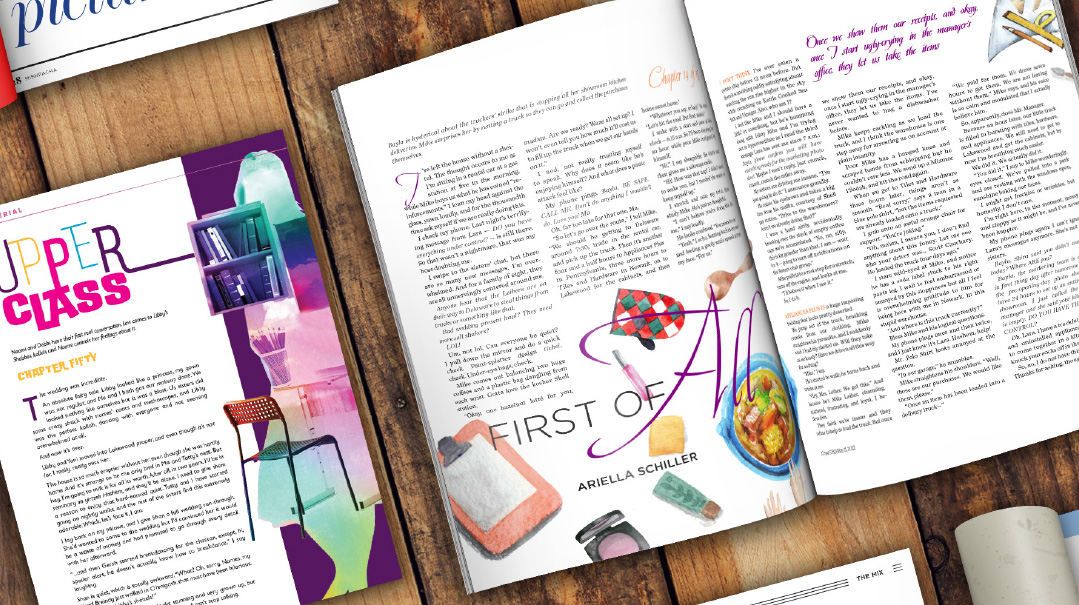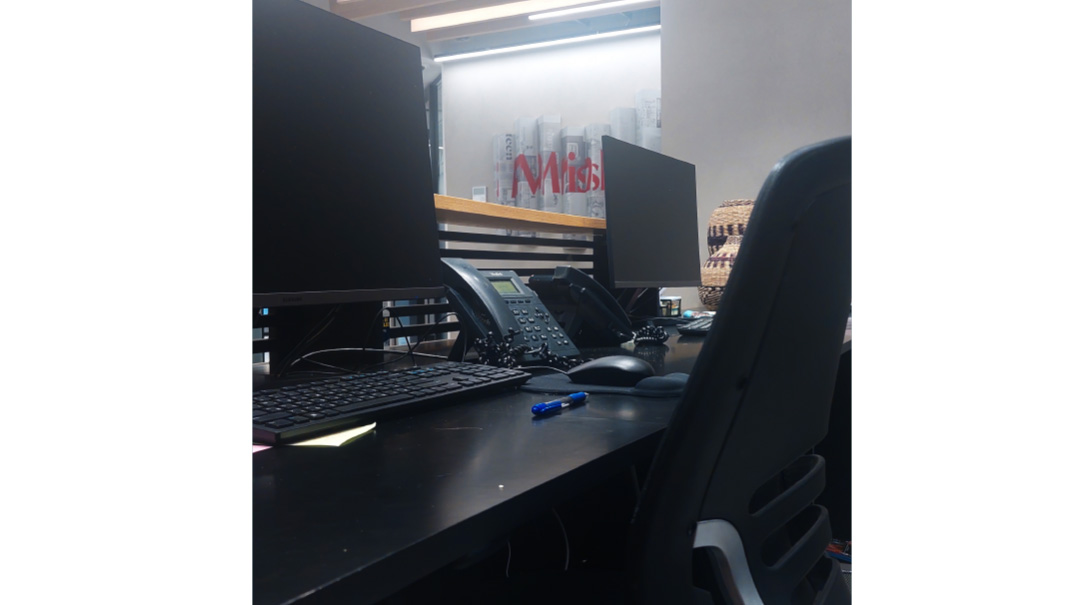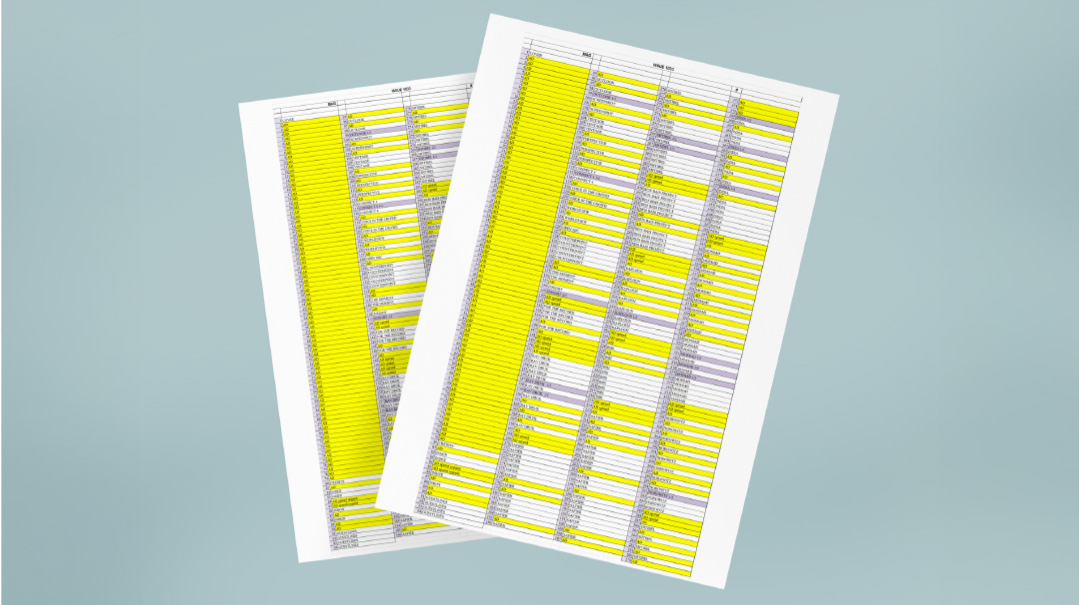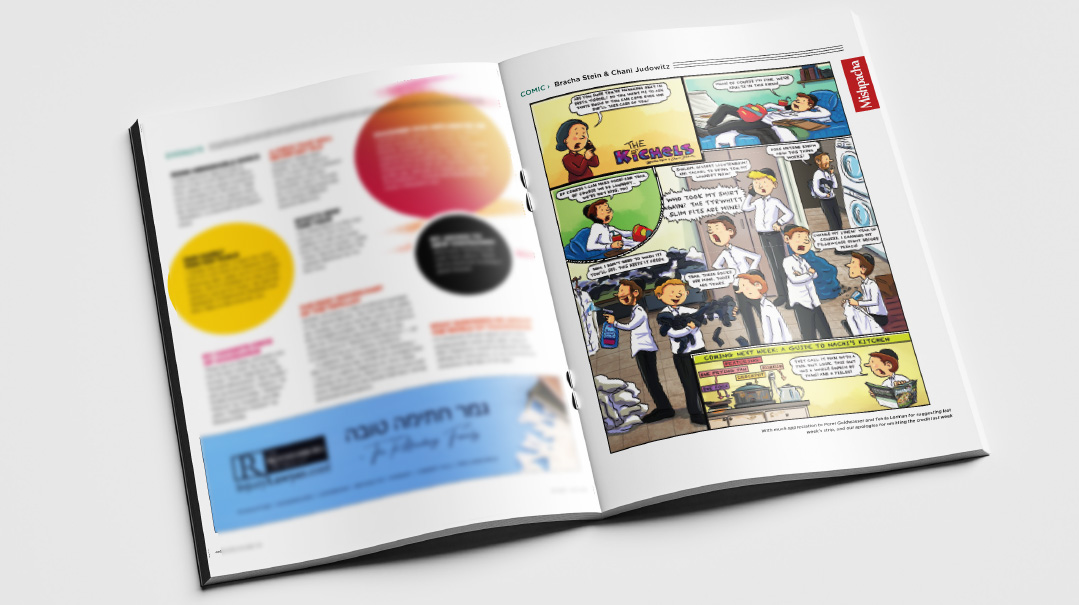20 Questions… for Dovi Safier and Yehuda Geberer
| April 8, 2025“The goal isn’t just to retell a story or profile an individual, but to add something new”
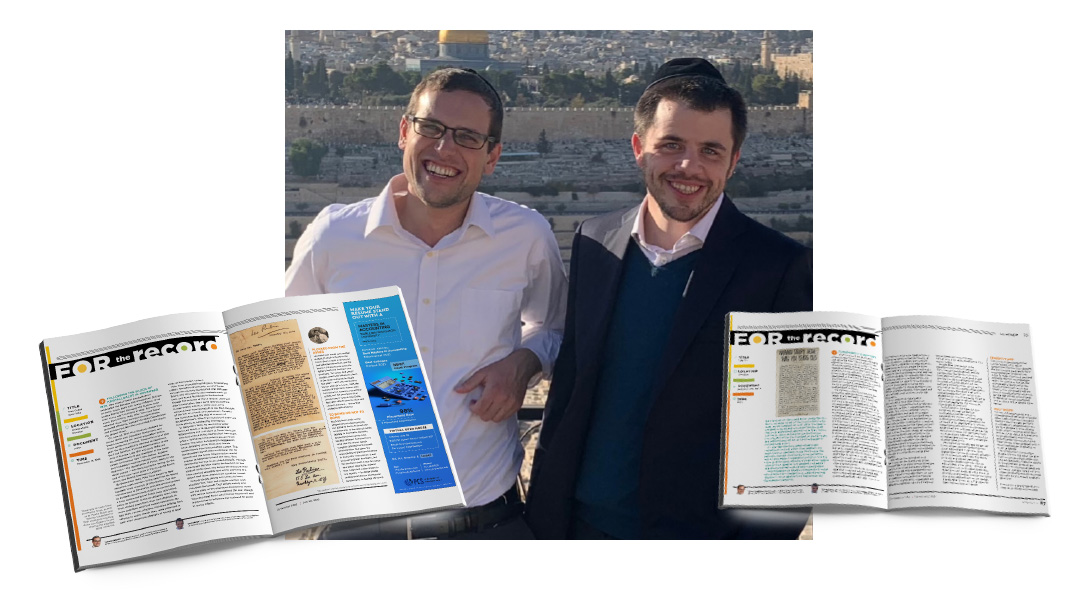
Setting the Jewish history record straight and providing all of those off-the-record details, columnists Dovi Safier and Yehuda Geberer combine their research skills and love of our nation’s past to produce For the Record each week, a highlight for many readers. In their other lives, Dovi is a New York-based business professional, and Yehuda, who lives in Beit Shemesh, is a history lecturer and tour guide.
My ideal work environment
Yehuda: Mornings at home
Dovi: My office, long before the world has awoken and the phone starts buzzing
Deadlines make me
Yehuda: Tense
Dovi: Ask for an extension
The accomplishment I’m proudest of
Yehuda: Getting the column done consistently on a weekly basis
Dovi: Us being awarded eight Simon Rockower Awards for Excellence in Jewish Journalism over the past three years by the AJPA. (I’m not as modest as Yehuda.)
The best piece of advice I’ve ever received
Dovi: The rosh yeshivah of Yeshiva of Far Rockaway, Rav Yechiel Perr ztz”l, once told me, “It’s great to study history, it’s even better to write about it. But the most important thing you can do is to try and make history.” That perspective reshaped the way I approach my work — not just as a historian, but as someone striving to contribute to the ongoing story of Klal Yisrael.
Yehuda: “Don’t write what you think is interesting or important. Write what you imagine the readers will enjoy” — from Dovi in the early years of our collaboration.
1
How was For the Record conceived?
Yehuda: Dovi would share interesting Jewish history finds from books, newspapers, and other sources on various platforms. His engaging posts caught the attention of Yisroel Besser, who suggested that Mishpacha ask Dovi to write a column. I had launched the Jewish History Soundbites podcast around the same time — May 2019 — and it was gaining popularity for its relevant take on modern Jewish history. Dovi and I have been close friends and chavrusas since our days in the Mir (we still learn together at the annual Yarchei Kallah), and he graciously asked me to join him. The format aligned well with my research and in some ways mirrored the style of the podcast.
The timing was providential. Our first column was commissioned for Pesach 2020. When Covid hit in March 2020, my tour business in Eretz Yisrael and Europe shut down overnight, and the column kept me busy and relevant in an uncertain time. When tours eventually returned, I found myself busier than ever — turns out, everyone wants a tour guide who’s also a Mishpacha columnist.
2
What are your guidelines for what material you feature?
Yehuda: We focus on modern Jewish history, typically defined as the era beginning in the 18th century and continuing to the present — though we joke that Dovi insists it’s limited to the years between the opening of the Volozhin Yeshiva in 1803 and the passing of Rav Aharon Kotler in 1962. There have been some exceptions where the column reached back further into history, though.
The centerpiece of every For the Record column is the exhibit — an artifact, poster, newspaper clipping, or another tangible piece of history — while the text provides the commentary and context. Sometimes we start with a topic and track down an exhibit to match, while other times, an extraordinary exhibit catches our attention, and the column becomes a deep dive into the story behind it.
3
How long does it take to compile this column? What’s the process?
It varies, but a typical For the Record piece takes several hours of research. Some articles require combing through a dozen sources, others lead us down a weeks-long path of interviews, archives, and historical cross-checking to ensure that our facts are correct. The goal isn’t just to retell a story or profile an individual, but to add something new — to uncover an overlooked detail, correct a historical error, or provide fresh context to a well-known episode.
4
How do the two of you collaborate weekly when you live 7,000 miles apart?
Dovi: We are extremely proud that For the Record is just weeks away from its 250th consecutive week in print — a milestone that speaks to the strength of our partnership. Like any successful collaboration, it requires recognizing each other’s strengths and being open to differing perspectives. Yehuda is the more skilled writer, the better-trained historian, and has an encyclopedic knowledge of our subject matter. I’d like to think my strength lies in research — digging up the obscure documents, the forgotten footnotes, the missing puzzle pieces. It’s not uncommon for me to chase a lead so deep into a rabbit hole that Yehuda has to remind me we have an actual column to write. Our process is a constant back-and-forth, refining, sharpening, and sometimes completely reworking an idea. By the time a column is published, it’s been dissected and reassembled more times than we can count.
5
Do you have defined roles in putting the column together?
Yehuda: It’s testimony to Dovi’s good nature that our distinct roles in this process are delineated based on our respective strengths and limitations. Dovi is the organizer and visionary. He also is the master researcher of exhibits and great finds from all sorts of digital archives of newspapers and other artifacts. I try to provide the broader historical context and give the writing its flavor and essence. Dovi is also gracious about filling in for me when I’m on tour, and in general we are somewhat flexible about our roles, as we proceed through the weekly process of the four steps of writing the column: 1. Choosing the topic. 2. Researching the material. 3. Writing. 4. Editing.
6
What are your usual modes of research?
Yehuda: Books and articles primarily provide the background and/or directly inspire topics for our columns. Beyond that, we often consult knowledgeable scholars for advice, questions, and sources. One such scholar is the renowned talmid chacham and researcher Rav Dovid Kamenetsky, whose book on Rav Chaim Ozer Grodzinski, Rabbeinu Chaim Ozer: Rabban Shel Kol Bnei Hagolah (privately published in 2021), has emerged as one of the classic Jewish history works of the 21st century. Another is Dr. Benzion Klibansky, a leading historian of Lithuanian yeshivos, whose personal story is nearly as fascinating as his research. Born in Soviet Lithuania, he immigrated to Israel as a child and later gave up a high-ranking military engineering career to dedicate himself to the study of the Lithuanian yeshivah world. And then there’s the great Eli Neuberger, a dear friend from Baltimore with a seemingly endless knowledge on a wide range of subjects, including Jewish history.
Of course, we’d be lying if we didn’t include Wikipedia on this list. While not a primary source, it’s often an important starting point — especially the citations, which frequently lead us to critical books, articles, and archives.
Dovi: I love immersing myself in libraries and archives, both in person and virtually. Over the years, I’ve had the privilege of benefiting from two of the legendary archivists in the Orthodox world — Rabbi Moshe Kolodny, who ran Agudath Israel’s American Orthodox Archives for 45 years, and Mrs. Shulamith Z. Berger, longtime curator of Special Collections at Yeshiva University, which houses some of the most critical primary sources on American Orthodoxy. Both of them have made themselves available — way beyond their call of duty, whether it’s answering an email or phone call late one night to verify an obscure fact or track down an elusive document or book.
Beyond that, I’ve been fortunate to benefit from the knowledge, kindness (and patience) of some of the real giants in the field of Jewish History — Professor Shnayer Leiman, Rabbi Dr. Zev Eleff, Rabbi Dr. Aharon Rakeffet-Rothkoff, and Beth Medrash Govoha archivist Moishe Dembitzer, to name just a few.
7
Who or what did you learn the most from writing about?
Dovi: Rabbi Leo Jung (1892-1987), one of the 20th century’s most important rabbinic leaders and activists. I profiled him for the Shavuos 2022 issue and still get approached by people from across the spectrum thanking me for giving them the opportunity to learn about such an underappreciated giant among men. The sheer scope of his work on behalf of the Jewish people is staggering. For over seven decades, he shaped American Orthodoxy, secured vital funds for starving yeshivah students in interwar Europe, and helped Sarah Schenirer transform Bais Yaakov into a movement. His hatzalah efforts during the war were equally remarkable — personally securing 1,200 affidavits that saved over 9,000 Jews. He also trained young leaders like Rav Gedalia Schorr and Mike Tress in the complex visa process, ensuring the work continued beyond him.
Yet what struck me most wasn’t just his activism, but his profound sensitivity to the dignity of those he helped. Through his Rabbanim Aid Society, he and his wife sought out struggling Torah scholars, discreetly sending badly needed funds before Yom Tov, and even ensuring that a rebbi in Brownsville received a new set of teeth. One talmid chacham, too proud to accept charity, insisted on meeting Rabbi Jung at a neutral location to receive his check. Rain or shine, Rabbi Jung made those quiet, dignified deliveries. I could go on and on, as the article barely scratched the surface.
Yehuda: The Buffalo Rebbe, Rav Eliyahu Yosef Rabinowitz. We wrote a very short tribute column, way back in the beginning of our For the Record journey, and Dovi found something about his attempt to alleviate the plight of agunos, which we included as a one paragraph “Did you know.” But that ultimately sent me down a rabbit hole, and I ended up researching the agunah question among the American immigrant community at the turn of the 20th century. I learned a lot about immigration during that time period and the role of Jewish leadership in attempting to help alleviate the challenges of individual immigrants during that time. I later wrote up my findings as a paper submitted at Hebrew University.
8
What is the most surprising discovery you’ve made in the course of your research?
Dovi: While researching the history of the pilgrimage to the kever of Rav Elimelech of Lizhensk, I discovered an unexpected personal connection. A relative of mine, Boruch Safier — a Lizhensk native who returned in 1959 from the Soviet gulag — was the one who rediscovered the original matzeivah in a local marketplace and became the caretaker of the newly restored tziyun. I grew up hearing my grandfather’s memories of his childhood in Lizhensk, but I never imagined that a family member had played a role in ensuring that generations to come would still have a place to daven and connect to the great tzaddik.
Yehuda: Perhaps it was discovering the historic letter that led to the column “Don’t Talk, Just Daven” (Issue 972). In what is likely the earliest detailed account of a Jewish wedding on American soil, Founding Father Benjamin Rush, a non-Jew, attended the 1787 chuppah of Rachel Phillips and Michael Levy. He vividly describes how, at precisely 1 p.m., the men in the room suddenly covered their heads with hats and began to pray (Minchah). But what truly caught his attention? “The freedom with which some of them conversed with each other during the whole time of this part of their worship.” And just like that, in 1787 Philadelphia, a signer of the Declaration of Independence had unwittingly documented one of the few “minhagim” that had crossed the Atlantic intact: talking during davening.
9
Have you made any interesting connections through your column?
One of the most fascinating connections we made through For the Record was with a Polish researcher named Piotr Nazaruk. After we published “Pushke, Pushke on the Wall” (Issue 871), which mentioned Rav Meir Shapiro’s pushke campaign, he reached out via our editors to inform us of his project — an effort to catalog the remnants of the legendary library of Yeshivas Chachmei Lublin. His work immediately intrigued us and led to “The Legend of the Lost Library of Lublin” (Issue 939), a feature on the history of the library and the ongoing efforts to trace its scattered volumes. That article, in turn, prompted several readers to reach out with details about seforim they owned that had once belonged to the yeshivah’s vast library.
Another tip from Piotr led to “Voices from a Vanished World” (Issue 1009), a column about a remarkable find — a long-lost archive of letters written by Jews around Poland to the yeshivah, which were recently returned to the Lublin Jewish community by the daughter of a German soldier who had been holding onto them for 80 years. The letters provided a rare glimpse into the mindset of yeshivah students in interwar Poland, their struggles, aspirations, and unwavering commitment to Torah learning. Piotr was also extremely helpful in the research for Dovi’s major feature, “A Light From Lublin: Rav Meir Shapiro’s Quest To Build Chachmei Lublin” (Issue 980).
10
What is your all-time favorite column?
Dovi: “They Called Upon Mike” (Issue 920), which focused on a letter discovered in the archives of Agudah leader Mike Tress. In the 1944 letter, a 15-year-old Torah Vodaath student named Leo Rubin proposed a daring plan to Mike Tress, whom he assumed had regular access to President Franklin D. Roosevelt: air-dropping weapons and paratroopers into Nazi concentration camps to help prisoners revolt. While the idea was unfeasible considering Agudath Israel’s resources and Roosevelt’s unwillingness to meet with Orthodox leaders, Mike Tress didn’t dismiss it outright. His willingness to listen and explore every possible avenue, no matter how improbable, underscored his relentless determination to save Jewish lives in the worst of times. We were able to fill in the missing gaps in the story with the help of lots of genealogical research and a grandson of Mike Tress, the well-known Lakewood askan Moishe Tress — who helped us get in touch with Sabrina Silverman, the daughter of Leo Rubin.
Yehuda: “Holy Dirt” (Issue 1038), where we wrote about the industry of importing dirt from Eretz Yisrael and selling it in European communities for local chevra kaddishas to use in burials. The ideal role for me is be a conduit for all the great research and stories out there in various academic books (mostly in Hebrew), bringing it to a popular audience. My other priority is to convey a message of social history, how the Jewish People as a whole lived, and not just lives of gedolei Yisrael and otherwise well-known individuals. This story satisfied both criteria.
11
What memorable reactions did you get to your most famous article, “Mother of All Yeshivos: Uncovering the Forgotten Legacy of Mrs. Jennie Miller Faggen” (Issue 956)?
There’s no question that knowing how much the story meant to the manhig hador, Rav Shmuel Kamenetsky and his rebbetzin Tema, gave me the push to work harder on it than anything I’d ever done before, and after three years of research (and ongoing work on a full-length book), I had a feeling the article might generate some buzz. But I never imagined it would add a new name to our collective lexicon.
In the months that followed, yeshivos reerected plaques honoring her legacy, and Torah Umesorah began sending out an annual yahrtzeit email, encouraging schools across the country to dedicate Torah learning in her memory. And her kever, once forgotten — has become a makom tefillah, where people now come to pour out their hearts.
We’ve written about giants. We’ve profiled builders. But this was something else. Somehow, a woman who had been almost completely erased from memory — and didn’t leave behind a single descendant — is now, rightfully, part of the conversation again. I set out to tell the story of a forgotten patron of Torah. And somehow, Jennie Miller Faggen has become part of the world she helped build, once again.
12
What interesting feedback have you received from readers?
Dovi: A reader once sent us a detailed critique of a 15,000-word Yom Tov article we’d written, because he’d noticed a missing comma and a misspelled word. Incredibly, his letter included a lot more than two grammatical errors as well as several misspelled words. However, the most important feedback comes from our editor, Mrs. Shana Friedman, who goes way beyond the call of duty to ensure that our columns always shine — especially the Yom Tov articles, which inevitably lead to her working ungodly hours to ensure perfection. Nothing we’ve written would have achieved the gold standard without her professionalism and expertise.
Yehuda: A participant on one of my Europe tours told me he grew up in Massapequa, Long Island, which isn’t known for its robust Torah community, to say the least. He was never proud of his hometown in any spiritual or Jewish sense until he read our column on “Sabbathville, USA” (Issue 879). Dovi had discovered this fascinating story of Rav Shraga Feivel Mendlowitz’s attempt at building a shomer Shabbos suburban community, which ultimately fell through due to lack of funding. The site of Sabbathville is today’s Massapequa, and that simple column had made this special Yid finally feel proud of his hometown.
13
Is there a piece you’d love to write but know is not going to happen? Why?
Dovi: In general, I’ve never been able to write a tribute piece about someone I was related to or very close with after their passing — it’s just too painful. The only exception was the Mir Mashgiach, Rav Aharon Chodosh. Yehuda, who was even closer to him, took the lead on that project and encouraged me to join him in the endeavor — something for which I am eternally grateful.
Yehuda: The basis of the column is an artifact, exhibit, newspaper clipping, etc. All text is commentary and context surrounding the exhibit. There are many fascinating topics we’d like to write about, but since we’ve never found an exhibit on that particular topic, we’ll have to save it for another platform. One topic which I’ve researched and comes to mind is interwar Polish Jewish political parties. Though a fascinating and relevant topic — many modern-day political parties in Israel have roots in interwar Poland’s Jewish parties — the context of the time and the challenges facing Jewish political parties and leaders make it an incredibly challenging project to convey to a modern-day audience. The nuance of the political platforms and disputes must be understood within the dynamic of that time, and it would take lots of effort to get the story right, and not have it misunderstood.
14
Who is the most interesting, unlikely, or far-flung reader you have?
Dovi: An Ivy League professor of European History read our article on Rav Leib Malin and invited me to address his class over Zoom. His students were fascinated by why Torah study was so central to yeshivah students that they risked their lives to flee Soviet-controlled Lithuania, despite having no clear destination, simply to avoid living under Communist rule.
Yehuda: There’s lots of crossover between our For the Record column and my podcast; many readers of the column get interested in the podcast and vice versa. I recently did an episode on the podcast about the Tiferes Yisrael/Nisan Bak shul in the Old City of Yerushalayim, and I had mentioned the 19th century Yemenite neighborhood of Kfar Shiloach on the foothills of Har Hazeisim in that context. We followed up that episode with a column in Mishpacha on the same topic. A listener who resides in that very neighborhood reached out and described the flourishing community, offering a guided tour to anyone who wants to observe this fascinating story up close. He added, “Since the beginning of the war and different rounds of miluim (reserves), listening to your podcast has been a source of pleasure and tranquility. Between Shabbos cleaning at home and taking care of our tanks, your podcast has been listened to in all places and situations.” I was really touched that the podcast, and the Mishpacha column as well, is accompanying the Jewish People on the battlefield and at home, in all situations.
15
Is there a column you wish you could take back?
We once wrote about a great rabbinic figure and mentioned a well-known grandson. Soon after publication, we received a letter from another descendant — a noted talmid chacham — asking why we had omitted his name. At first, the letter seemed trivial, but it made me realize how much these stories mean to people. When you’re writing history, you’re also writing about people’s families, their legacies. It was a reminder to always be meticulous and sensitive.
16
Is there someone or something you get asked to write about but never do?
We often get asked to write about Rav Chaim Avraham Dov Ber Levine (1860–1938), known as “The Malach.” He was a towering, yet enigmatic figure in American-Jewish history, a disciple of the Rebbe Rashab of Lubavitch who brought a radical asceticism and uncompromising spiritual vision to the New World. His small but devoted group of followers in New York saw him as a living link to the purity of old-world chassidus, but his approach set him apart from the mainstream chassidic world. It would be difficult to write about him in a way that properly conveys the complex background and delicate nuances that led to his and his followers’ estrangement from the small American Torah world of the time while maintaining the appropriate reverence for all involved. Quite simply, it’s not a story that can be told responsibly within the scope of a single article; it would require a book.
17
Who are some of the most fascinating people you’ve interviewed?
Dovi: During the pandemic, I realized that many people who were generally too busy for long conversations were stuck at home and would likely appreciate a good phone or Zoom discussion. That realization led me down a path of almost nightly conversations with some of the most storied figures in American Orthodoxy. I will always cherish the many hours I spent talking to Rav Yechiel Perr and Rav Elazar Meir Teitz, the late Rav Ha’ir of Elizabeth, New Jersey, two great men with tremendous insight and an incredible appreciation for the type of historical anecdotes I love. Their recent passing has been a personal loss for me as well as obviously a significant loss for Klal Yisrael.
We’ve also had the opportunity to engage in deep conversations with several members of the greater Soloveitchik family, including Rav Meir, Rav Dovid, and their sister Rivka and her husband, Rav Yankel Schiff — who regaled us with stories of his rebbi, Rav Aharon Kotler, and how his shidduch with the daughter of the Brisker Rav came to be.
Yehuda: For some years, I had the privilege of serving as an interviewer for Yad Vashem, traveling to survivors’ homes with a camera crew to record their stories for the archives. Some of the most memorable interviews I conducted included a Hungarian survivor from Miskolc whose grandfather was a chassid of Rav Shayale of Kerestir, a woman from Zhetl (birthplace of the Chofetz Chaim) who took part in the legendary Novardok tunnel escape and later joined the Bielski partisans, and Dr. David Sompolinsky, a 98-year-old Danish Jew who lived in Bnei Brak and was the last surviving organizer of the rescue of Danish Jewry during the Holocaust and had coordinated efforts with the heroic members of the Danish resistance.
Beyond my work with Yad Vashem, one of the most fascinating interviews I conducted was with Rav David Attiah, the youngest son of Rav Ezra Attiah, rosh yeshivah of Porat Yosef. He shared remarkable memories of his father and the early years of the flagship yeshivah of Sephardic Jewry in Yerushalayim, which we featured in our article “Eyes That Saw Angels” (Issue 854).
18
One thing that is particularly enjoyable about reading For the Record are the uniquely creative titles you come up with. What are some of your favorites?
We enjoy being nostalgic and occasionally use classic song titles or lyrics that fit the theme for our titles. Whether it’s Yerachmiel Begun and The Miami Boys Choir (“The Torah’s Only Defender,” “Don’t Talk, Just Daven”), Abie Rotenberg (“Up, Up & Away — Oh What A Purim Day”, “They Called Him Reb Shmuel,” “Mama Rochel Cries for Boro Park”), Country Yossi (“Cholent Is Its Name,” “Every Heart Was Broken That Yom Kippur”), Shmuel Kunda (“When Zaidy Was No Longer Young”) Suki & Ding’s classic Uncle Moishy songs (“Ain’t Gonna Work on Saturday” and “Big Gedaliah Bublick”). But really anything that allows us to exercise our creativity and gives readers a reason to smile.
19
What do you see in the future for For the Record?
Dovi: We both have day jobs and families, so writing a weekly column is more of a passion than a profession. There are times that we both think the column has run its course, but the constant feedback from both Mishpacha staff and our devoted readers (keep it coming!) has kept us from throwing in the towel. At the same time, we both would like to finish writing our respective upcoming books and work on other projects, too, so time will tell. We’re also toying with a different concept for our Mishpacha column, which may appear over several weeks this summer.
20
As For the Record marks its fifth anniversary, is there a moment that stands out as a defining one, where you truly felt the impact of your work?
Dovi: Yehuda and I are fortunate to know many talented and knowledgeable people who assist us in our research. One of them is the renowned genealogist Mrs. Chaya Sarah Herman, with whom we’ve collaborated on numerous projects, including tracking down passport photos of gedolei Yisrael from archives across Europe.
In 2021, when Reb Shimon Glick informed me that Rav Dov Landau was visiting my neighborhood during his first trip to America, I wondered if there was something meaningful we could bring him. I reached out to Mrs. Herman and asked if, by any chance, she could locate the Lithuanian passport photo of Rav Dov’s father-in-law, Rav Yosef Sher, who was murdered in the Holocaust — a man Rav Dov had never met. Sure enough, she found one. When I presented it to Rav Dov, he was visibly moved. Until that moment, he had only seen a single grainy photo of his father-in-law at a much younger age.
The next day, someone forwarded me a photo of Rav Dov visiting Rav Shmuel Kamenetsky. As I looked closely, I noticed something — Rav Dov was clutching the very same photo I had given him the day before! Later, one of Rav Dov’s grandsons explained why. Since Rav Dov had only ever seen one other photo of his father-in-law, he wasn’t 100 percent certain that this was truly him. He couldn’t bring himself to show it to his rebbetzin — who had been separated from her father as a young girl — until he was absolutely sure. And so he brought it to Rav Shmuel Kamenetsky, the zakein hador, who had learned in the Slabodka yeshivah ketanah, hoping he could authenticate the photo. Rav Shmuel examined it and confirmed its authenticity.
(This episode hardly ended there, but you’ll have to wait for a future column for the rest of the story.)
(Originally featured in Mishpacha, Issue 1057)
Oops! We could not locate your form.


